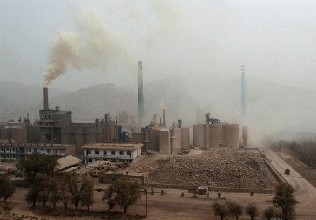

Xingtai, Hebei Province has long been known as the "dirtiest city in China." The city, like many others in China, focused on developing heavy industry and is now choking with smog. In 2013, the provincial government issued an order to reduce steel production and clean up the air, but that caused unemployment and left the Xingtai government in debt. The city needs, but lacks, a long-term plan to completely clean up its air.
"The smog has come again," Li Zhong, a resident of Xingtai, Hebei Province, posted to WeChat on October 24. That day, Xingtai's air quality index measure of PM2.5 was a hazardous 500, officially "off the charts." Li said that he has almost forgotten what blue skies look like.
It was the third time that month that Xingtai had a day with hazardous levels of pollution.
For a long time, Xingtai has been called "the dirtiest city in China." Over the last few decades, the city has heavily relied on burning coal to support its massive steel industry and it is now paying the environmental price. Due to their proximity to Beijing, many cities in Hebei have started to try and clear away their smog by shutting down factories.
However, shutting down factories has caused unemployment and a reduction in taxes paid to the Xingtai local government, which is already in debt. Furthermore, the air quality problems cannot be solved simply through short-term measures and the government doesn't seem to have a long-term plan yet.
Starless nights
Li has lived in Xingtai for more than 10 years since he graduated from college. When he first came to the city, if he rode down the west second ring road on his bike he would see red smoke looming over the city. That smoke was pollution from Xingtai's many factories.
He has had to wash his car every day recently, the Oriental Morning Post reported. All the cars, buildings and people in Xingtai have been turned gray by the smog.
Chang, a retired tax bureau worker in Xingtai, said that he hasn't been able to see the stars for a long time.
A villager surnamed Su who lives near the Dongpang mining area in Xingtai told the Oriental Morning Post that he doesn't know whether his lungs have become black yet; he only knows that there's a field full of soot in front of his house and every time the wind blows, he "can't even open [his] eyes."
The "dust storms" come randomly, depending on the wind, Su said. They usually cover his entire cornfield with black powder. He has to sweep his courtyard twice a day to clean the soot away, his wife never hangs her clothes to dry outside and sometimes even their water turns black.
According to a report by the World Health Center in May on the average PM2.5 concentration in 190 cities around the world, Delhi was the worst city analyzed with an average of 153 micrograms per cubic meter. According to a report published by environmental NGO Greenpeace in July, the average density of PM2.5 from January to June in Xingtai was 152.6 micrograms per cubic meter.
Heavy pollution is so common in the city, most Xingtai residents don't think of the smog as bad weather, the Nandu Weekly reported. Only a few people wear masks on the streets, even on hazardously polluted days. An electronics store manager told the paper that not many people buy air purifiers either.
Xingtai has a long history of heavy, polluting industry. In 1956, a city planning office was established in Xingtai and it said that the city's industrial development should focus on "steel, mechanics, chemical engineering and textiles."
Because the city, like the rest of China, was in a hurry to develop quickly, many enterprises didn't have legitimate paperwork when they operated, Wang Dayong, secretary general of the Hebei Metallurgy Industry Association, told the Oriental Morning Post.
As the city expanded rapidly, industrial areas became enveloped by housing. According to data from the Xingtai Environmental Protection Bureau, within 25 kilometers of the city center, there are three power plants, four steel mills, two coking plants and more than 40 glass-manufacturing plants.
Copyright ©1999-2018
Chinanews.com. All rights reserved.
Reproduction in whole or in part without permission is prohibited.